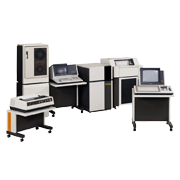Sharp developed the HAYAC-7000 office computer using the latest LSI technology to implement a multiprocessor system. It first went on sale in June 1981. The multiprocessor architecture allowed the computer to split the processing load between CPUs and, thus, accelerate its data processing speeds.
The model's primary features were as follows:
-
- (1)The HAYAC-7000 processed large amounts of data at high speeds with two high-performance 16-bit microprocessors that ran independently of each other.
- (2)A multi-work function permitted the construction of workstation systems that could parallel process up to 32 separate tasks simultaneously. These systems were highly reliable and had ample room for future task expansion with connectivity to up to 64 input and output devices.
- (3)The virtual memory, which had a huge logical address space of 1 megabyte, was designed not only to make effective use of the main memory unit but also to allow programmers not to worry about the main memory size when developing programs.
- (4)A file management processor increased the processing speed of the internal magnetic disk unit by 30 percent over Sharp's previous models.
- (5)The HAYAC-7000 offered a wide range of system architecture options to suit different applications, such as Japanese text processing and image processing of graphics and text as well as numerical processing. It could also be combined with or expanded to include email and electronic files.


